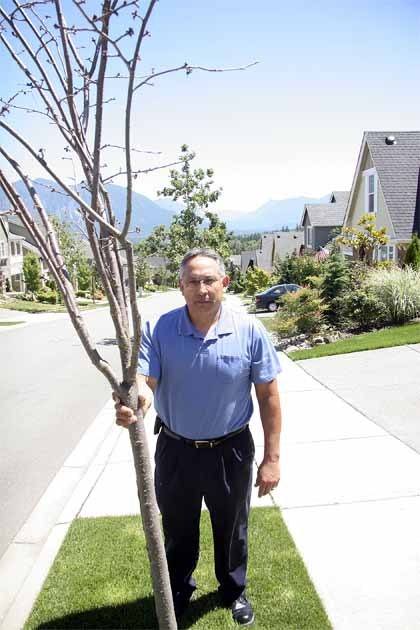Snoqualmie’s Parks Director, Al Frank examined the slender cherry sapling on Snoqualmie Ridge’s Pinacle Place and saw the same telltale problem signs he’d found throughout the area’s neighborhoods.
The little cherry tree looked like it had just been planted. But the tree, just like the others lining the block, had been planted five years ago.
“They haven’t grown at all,” Frank said.
The spindly tree had few leaves or branches and is barely nine feet tall. It should be 20.
“It’s because of the soil. The roots can’t get down,” Frank said.
Snoqualmie had to change its tree planting standards about four years ago, after discovering massive die-off of young trees in the first phase of Snoqualmie Ridge. Frank explained that, under the old tree-planting standard, trees were planted in a hole four feet across. But in many places, that hole didn’t give the tree enough room to grow, because Ridge developers had scraped the earth down to hard-pan soil to build.
While some trees do fine, many others cannot break through the hard soil. Limited room for roots mean a limited life span
“They will grow like normal, up to about five, six years, and all of a sudden, they start to die because the roots aren’t getting out., or the wind will come and blow them down,” Frank said.
Neighborhood developers are held to maintenance agreements to replace trees during a certain time from the end of construction. But a lot of trees survive just past the end of that period, putting the burden on the city.
Amy Atchison, director of the Snoqualmie Ridge Residential Owner’s Assocation, said her office frequently takes call from residents frustrated by dead trees in front of their homes.
Atchison explains to homeowners that it’s the city’s responsibility to replace those trees.
There doesn’t seem to be any one neighborhood more or less favored with tree problems, Atchison said.
According to Frank, it costs the city roughly $700 to replace each tree, about $200 for the tree alone. Last year, the city replaced 40 trees on the Ridge, and has a backlog of 250 trees to replace overall.
“That’s quite a bit of money,” Frank said.
The die-off pushed new tree-planting standard in the Ridge’s Phase II. Under that standard, a tree hole is 10 feet on each side. The hard pan is dug up and replaced with a mix of native soil and compost.
“Snoqualmie Ridge II is taken care of,” Frank said.
The new standard is also used when replacing trees in the phase one neighborhood. It’s successful about 80 percent of the time. The city isn’t sure why, but Frank said the solution is to keep replacing the soils.
This summer’s recent lack of rain may have also played a part in stressing city trees.
While most trees are irrigated, in some areas, there is no irrigation to trees.
“It’s up to the homeowner to water the trees in front of their homes,” Frank said. “Some people don’t like to water their lawns, because it costs money. That does play a factor if the tree survives or not.”



